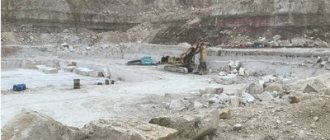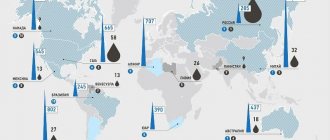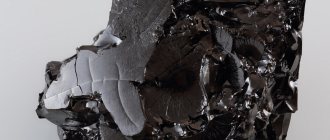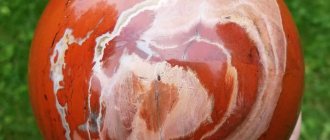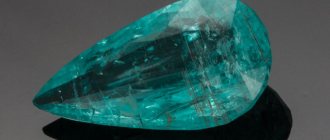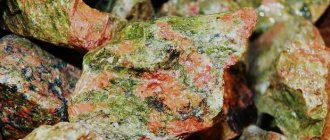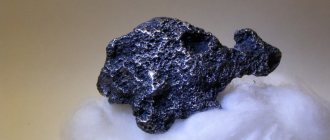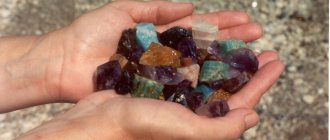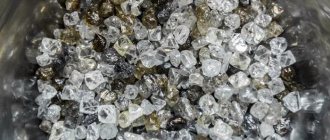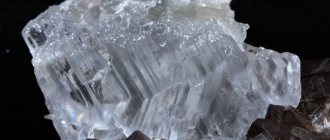Skarn deposits
Skarn deposits are formed in zones of contact between igneous rocks and their host sedimentary or effusive-sedimentary rocks. That is why they are often identified with contact-metasomatic ones. However, after the work of D.S. Korzhinsky, who pointed out the important role of the exchange of components of rocks differing in composition, the terms “contact-metasomatic” and “skarn” should not be considered synonymous. The term “contact-metasomatic deposits” is broader: it includes both skarn deposits and deposits not associated with skarns, but arising in the process of metamorphism at the contacts of various rocks, for example, hyperbasites and sericite-quartz schists ( talc ). Skarns are understood as contact metasomatic rocks composed of a certain complex of minerals, the leading role in which is played by garnet, pyroxeps, wollastonite , vesuvianite, scapolite, spinel, humite, tremolite and some others. Contact rocks that arose without metasomatism, but with a composition close to skarns, are called skarnoids.
Metasomatic rocks that accompany skarns, but have a different mineral composition from them, are called near-skarn rocks . An example is diopside-plagioclase rocks, composed largely of plagioclase, which is not typical for skarns. Skarns develop both from the host rocks and from the intrusions that break through them. Skarns that arose at the expense of host rocks are called exoskarns, and those that replaced intrusive rocks are called endoskarns (Fig.).
Rice. Scheme of the location of endo- and exoskarn zones at the contact of igneous and host rocks: 1 - limestones; 2 - granites; 3 - exoskarns; 4 - endoskarns
Among the skarn rocks there are calcareous skarns, which developed in the contact zone between intrusions and limestones, and magnesian skarns, typical of the contact zone between intrusions and dolomites. There are also silicate skarns formed over aluminosilicate rocks (for example, tuff sandstones, volcanic tuffs, etc.). Magnesian and calcareous skarns differ in mineral composition. Among the minerals of calcareous skarns, garnet, wollastonite, pyroxenes, epidote, vesuvian, and calcite should be mentioned. Magnesian skarns are characterized by forsterite, diopside, humite, serpentine, phlogopite, garnet, chloritoid, and calcite. The composition of these skarns is dominated by minerals containing magnesium.
Most skarns occur at relatively shallow depths (1–3.5 km). However, according to D.S. Korzhinsky and V.A. Zharikov, magnesian skarns are formed at a considerable distance from the surface. According to calculations by V. A. Zharikov, the depth of their formation can reach 30-40 km. But, probably, in most cases it does not exceed 15-20 km. The initial temperature of skarn formation is usually no more than 900 °C, and the skarn process ends at temperatures of 100 °C, perhaps 50 °C. Some skarns can form at the magmatic stage, that is, during the period when the magma that has penetrated into the host rocks has not yet solidified. This applies, according to the views of D.S. Korzhinsky, to magnesian skarns. The bulk of skarns are formed during the period when magma, at least in the upper contact zones, crystallizes. This is evidenced by the fact that not only host, but also magmatic endocontact areas are subject to skarning; in addition, skarning often develops unevenly - it uses tectonic zones that arise in solid rocks. In this regard, it is interesting to note that skarns usually develop not along the entire contact between host rocks and intrusions, but along areas of the contact that have experienced tectonic movements. These movements could only take place after the magma in the contact zone had solidified.
The development of endo- and exoskarns occurs with the counter-movement of components. From intrusive bodies, aluminum , silicon and other petrogenic elements, as well as a number of metallogenic elements, usually enter the host rocks, and calcium, sometimes magnesium and other elements penetrate into igneous rocks. The exchange of components can be carried out by diffusion through slowly percolating or almost stagnant waters, and skarns are called diffusion skarns . The thickness of diffusion skarns is, as a rule, small and measured from centimeters to a few meters, less often tens of meters. In many cases, components are transferred not by diffusion, but by a directly moving flow of aqueous solutions, i.e., infiltration. Such skarns are called infiltration skarns . The thickness of infiltration skarns, as a rule, is much greater than diffusion ones and can reach several hundred meters. In some cases, both diffusion and infiltration occur simultaneously on a noticeable scale.
Skarns are characterized by a zonal structure. This zoning is due to various factors, including different mobility of components and changes in the physicochemical conditions of skarn formation over time. For example, for the first reason, zoning can arise due to the fact that more mobile components penetrate to greater depths into contacting rocks and minerals are formed there with their participation. In a less distant zone, minerals are formed with the participation of more inert components. Components with increased mobility or “completely mobile” (according to D. S. Korzhinsky) in most cases include water, carbon dioxide and alkali metals. Titanium , aluminum and some others are usually inert Components change the degree of mobility depending on the physicochemical situation, and inert in some cases they can become completely mobile in others. Analysis of the change in mineral zones and the nature of the relationship between mineral grains makes it possible to identify series of relative mobility of components. For example, for diffusion formations in the Archean of the Baikal region, D. S. Korzhinsky gives the following series: H2O, CO2, S, SO3, CI, K2O, Na2O, F, CaO, O2, Fe, P2O5, BaO, MgO, SiO2, Al2O3, TiO2 . Mobility increases in this row from right to left, and the inert components include MgO, SiO2, Al2O3 and TiO2. For the Turinsky copper mines, this researcher established the following change of zones that arose as a result of the diffusion process:
- 0—zero zone of the original rock, i.e., unchanged quartz diorite;
- near-scarn rock composed of acidic plagioclase, quartz , diopside, sphene;
- near-skarn diopside-plagioclase rock;
- pyroxene-garnet skarn;
- pomegranate skarn;
- salite skarn (salit is a type of pyroxene);
- marbled limestone.
Zoning is inherent in both diffusion and infiltration skarns. But if in zones of diffusion skarns minerals of variable composition (pyroxenes, garnet, etc.) can change their composition across the strike of the zones, then in infiltration skarns the composition of minerals within each zone is constant.
The origin of zoning is explained by D.S. Korzhinsky and his followers mainly by changes in the composition of solutions along the path of migration of components. The change in solutions over time probably also played a certain role in the formation of zoning. The role of solution changes in changing the composition of skarn minerals was noted by P. P. Pilipenko. In his opinion, at the first stages of the skarn process, dry skarns arose, i.e., skarns with minerals devoid of the (OH) group, for example, garnet, wollastonite, etc. At the stages of water skarns, water-containing minerals were formed - amphiboles, epidote, etc.
In the formation of skarn deposits, thermal diffusion could have played a certain role in the extraction of useful components from magmatic chambers (including magmatic melts), leading to the migration of elements with a greater mass than silicon, oxygen, aluminum, magnesium and other major elements into the contact zones of intrusions . Such elements include iron , molybdenum , lead , zinc , etc. The mechanism of thermal diffusion can also explain the movement of elements captured during assimilation to the periphery. In other words, thermal diffusion can be an additional ore-generating factor, along with such as the borrowing of some components in the process of assimilation and contamination from the host rocks (for example, the enrichment of acidic magmas with iron during the capture of basic effusive rocks by the melt).
The formation of a number of types of mineral raw materials is associated with skarns, including deposits of iron, tungsten and molybdenum, copper , tin , lead and zinc, boron , wollastonite, phlogopite, beryl, arsenic , etc. The shape of the mineral bodies of skarn deposits is lens- and nest-shaped, stock- and sheet-like.
Categories Conditions for the formation of mineral deposits
Lecture 9 Skarn deposits
This group of deposits is one of the most complex and controversial. As will be shown below, a definite genetic connection between ores and skarns either does not exist, or it is distant paragenetic. However, in world ore geological practice for more than 50 years, no other name has been proposed for this vast, diverse and certainly heterogeneous group of ore formations. Let us consider in more detail the structural features, composition and possible formation models for the most typical deposits, which most geologists classify as skarns. Skarns are usually called rocks of calc-silicate composition, formed metasomatically most often, but not always, in the contact area of intrusions among carbonate, less often silicate rocks. There are exoskarns located outside the intrusions, and endoskarns located inside the latter. There is a wide variety of skarn bodies. These are layers, lenses, rods, pipes, veins, nests and complex combined deposits. Based on the composition of the parent rocks, skarns are divided into three types: calcareous, magnesian and silicate. Calcareous skarns are the most common in nature and are formed from limestones. Their composition: garnets of the grossular-andradite series and pyroxenes of the diopside-hedenbergite series. Vesuvianite, wollastonite, scapolite, amphiboles and epidote are sometimes widely developed. Magnesian skarns are rarer. They arise during the replacement of dolomites and consist of diopside, forsterite, spinel, phlogopite, monticellite, humite, serpentinite, pargasite, ludwigite and less commonly other minerals. Silicate skarns are rare formations. They are formed from granitoids, porphyries and their tuffs, traps.
These formations have been known since the Early Precambrian and are characteristic of platforms, mobile belts and areas of tectonomatic activation, where they are associated with plagiogranites, plagiosyenites and traps, derivatives of basaltic magma; with granodiorites of batholiths and granitoids of small intrusions, derivatives of granitic magma. Skarns can be associated with any phase of the intrusive process, sometimes with all. In the areas of their development, dikes are distinguished: 1) pre-skarn (granodiorite-porphyry, granite-porphyry, aplite...) 2) intra-skarn (first felsic and then basic composition); 3) post-skarns (diabases, lamprophyres). The geological structures of skarn formations are determined by: the contact surface of the intrusions; bedding of rocks hosting intrusions by folding and faulting.
Physicochemical conditions of formation.
Skarns are formed as a result of the combined effects of heat from intrusions and hot mineralized gas-liquid aqueous solutions.
During the formation of any intrusive body, the host rocks experience thermal isochemical metamorphism. Contact hornfels are formed over shales, quartzites over sandstones, and marbles over limestones. Zones of such transformations develop around intrusions at any depth and pressure. Under the influence of fluids released during the solidification of the intrusion, allochemical and metasomatic processes occurred at its endo- and exo-contacts, forming skarns. These phenomena occurred at shallow hypabyssal depths, where internal fluid pressure was able to overcome the external lithostatic load. The depths of skarn formation are optimal in the interval 0.2 ─ 0.5 km.
The following data allow us to judge the possible temperature regime for the formation of skarns: 1) synthesis of minerals in an environment of high calcium potential and the presence of easily soluble salts: andradite and grossular - 950 - 225 ° C; diopside tremolite and wollastonite - 750-350°C, hedenbergite - 320°C; 2) according to summary diagrams (V.A. Zharikov), constructed from experimental materials (calculation of the melting of silicate rocks, the reaction of silicate formation, the temperature of dehydration of aqueous silicates and dissociation of carbonates, etc.), four temperature phases of skarns can be distinguished: wollastonite-plagioclase — 900–750°С; pyroxene-garnet - 800-500°C; garnet-epidote - 500-450°C; pyroxene-epidote - 400°C; 3) according to the homogenization of inclusions in skarn minerals, the temperature range is 860–380°C. From the above information, we can conclude that skarns began to form at a temperature of about 900°C, and this process was completed at a medium-temperature hydrothermal regime (about 300°C).
The facies change of mineral associations in time and space due to a decrease in temperature is caused by an increase in the acidity of the process that regulates the chemical potentials of calcium, magnesium and iron (according to V. A. Zharikov). These associations are characterized by the displacement of calcium by magnesium, and then magnesium by iron. As a result, a sequential series appears: wollastonite-diopside-salite-he-denbergite-andradite.
The origin of skarns and skarn deposits is considered in more detail in two hypotheses - infiltration-diffusion, developed by D. S. Korzhinsky, and stage, proposed by P. P. Pilipenko.
Infiltration-diffusion
The hypothesis is based on the concept of bimetasomatosis, which explains the nature of many processes occurring at the heated contact of intrusive silicate rocks and limestones. Here a nonequilibrium chemical system arises and a counter-diffusion outflow of elements from areas of their increased concentrations begins. At frontal migration fronts, reactions occur between solution compounds and between them and rock-forming minerals. With different mobility of elements towards the contact of different media (diffusion front), their concentration in solution will decrease at different rates, causing zoning of mineral parageneses. The relative mobility of the components depends on the temperature of the process. A classic example of the study of bimetasomatic transformations is the analysis of the three-component diagram CaO: SiO2: Al2O3 carried out by D. Skorzhinsky. The original rock is quartz diorite. During the process of metasomatism, alkalis, oxygen, magnesium and iron are quite mobile. In this case, magnetite dissolves, hornblende and biotite are replaced by diopside, orthoclase by oligoclase. As calcium enters as a result of diffusion, quartz disappears and diopside-plagi-oclase near-skarn rock is formed. Further addition of calcium leads to the formation of diopside-garnet and then monomineral garnet rock. The massive supply of magnesium, iron and silica already in limestones contributes to the appearance of the diopside-hedenbergite zone.
The zonal structure is created by the growth of zones in the direction of the diffusion flow when the rear approaches the front ones. In accordance with the laws of metasomatism kinetics, sharp boundaries are formed between zones. During the transition from the avant-garde to the rear zones, the number of minerals decreases down to the monomineral latter.
The composition of the zones corresponds to a certain level of equilibrium and is characterized by a corresponding mineral association that is stable in a fixed temperature range. D.S. Korzhinsky identified 10 stages of equilibrium: high-temperature: 1) pyroxene-garnet, 2) pyroxene-epidote; medium-temperature: 3) actinolite-epidote, 4) chlorite-epidote and low-temperature: 5) prehnite, 6) pumpelliite, 7) calcite-albite, calcite-quartz-sericite-chlorite, 9) calcite-quartz-sericite-dolomite and 10) zeolite.
D.S. Korzhinsky identified 10 stages of equilibrium: high-temperature: 1) pyroxene-garnet, 2) pyroxene-epidote; medium-temperature: 3) actinolite-epidote, 4) chlorite-epidote and low-temperature: 5) prehnite, 6) pumpelliite, 7) calcite-albite, calcite-quartz-sericite-chlorite, 9) calcite-quartz-sericite-dolomite and 10) zeolite.
Of the ore elements, only iron can form deposits according to the bimetasomatosis model discussed above. So, first the iron is removed, and wollastonite appears instead of salite. Toward the outer boundaries of the intrusive contact, the iron concentration in skarns increases. Here, andradite appears instead of grossular and magnetite accumulates in large quantities. At later low-temperature stages, iron is an inert element, and sulfur and copper appear among the mobile ones. As a result of the interaction of these elements with previously released magnetite, chalcopyrite is formed. Therefore, in many iron ore skarn deposits, areas enriched in sulfides are constantly observed.
The concept of bimetasomatosis has the following disadvantages: 1) the balance of silica and CaO for skarns formed in limestones and granitunds, respectively, cannot be ensured by diffuse transfer of matter; additional input of these components is necessary; 2) it is impossible to explain the formation of skarns that occur exclusively among silicate or carbonate rocks, and especially those remote from intrusions; 3) in the proposed scheme there is no place for ore deposits with the exception of iron ore.
The concept of bimetasomatosis was later transformed by D. S. Korzhinsky into the infiltration-diffusion hypothesis. In the new model of the skarn process, it was assumed that deposits are formed in the zone of the boundary of silicate and carbonate rocks due to the circulation of hot solutions enriched with chemical compounds carried both from deep magma chambers and borrowed from rocks along the paths of movement of these solutions. At the entry point into the system, introduced compounds predominated. Further, their role is reduced and the process is carried out due to the counter diffusion of elements from silicate and carbonate rocks. As a result, the bulk of skarns were formed by a bimetasomatic method, and ore deposits are associated with the powerful influence of post-magmatic solutions circulating in fissure zones. However, this improved version of the hypothesis did not explain the reasons for the diversity of ore minerals in skarns and did not link the stages of the skarn process and ore formation.
P.P. Pilipenko, who developed the stage hypothesis, believed that the bulk of the substance of skarns and ores is introduced from the outside by specific solutions. As the temperature decreased, the composition of the introduced substances changed, causing mineral zoning. It is assumed that metasomatic processes were dominant, occurring in six stages. Flint was characterized by high temperature, the introduction of silicon and led to the formation of diopside rocks (light hornfels). 2. Aluminosilicate was carried out in the context of the introduction of silicon and aluminum and culminated in the formation of ferruginous garnets and pyroxenes. 3. The halide process occurred under the conditions of the entry of chlorine and the appearance of scapolite. 4. Iron was distinguished by the introduction of iron and its release in the form of ferrous and oxide compounds. Magnetite, hematite, and ferruginous aluminosilicates—hedenbergite, lieurite, garnets, etc.—accumulated.
During the first stages, anhydrous skarns formed. Then the fluid regime changed sharply. In the fifth fluid-water stage, H20 and CO2 entered the system and rocks appeared consisting of hornblende, epidote, sometimes with an admixture of scheelite and calcite. The process was completed by the sulfide stage, during which sulfides and sulfosalts were formed at low temperatures and a constant supply of H20, H2S and metals. Although the main idea of the hypothesis has been confirmed by practice, it does not explain the reason for the diversity of ore genesis products for different tectono-magmatic settings.
Based on geological data and experimental developments, the model of the skarn process can currently be presented in the following three-stage form.
Contact isochemical metamorphism occurs at temperatures of 900 - 650°C and accompanies the intrusion of magma. At depth, a powerful halo of light iron-poor barren diopside hornfels and marbles is formed.
1. The early skarn stage appears sporadically, occupying approximately one tenth of the perimeter of the intrusion. At temperatures of 650-400°C, “dry” anhydrous dark endo- and exoskarns appeared, consisting of pyroxenes, garnets, scapolite, hedenbergite, magnetite, and hematite.
2. The late fluid-aqueous stage occurs with the participation of H20, CO2, H2 and H2S, chlorites and complex metal compounds at temperatures of 450-300°C. Hornblende, epidote, calcite, sulfides and sulfosalts are formed.
Types of skarn deposits.
There are five options for their taxonomy: 1. According to the composition of the rocks being replaced: calcareous, magnesium and silicate. 2. By stages of the skarn process: 1) simple early stages (iron, tungsten 2) complex late stages (polymetals). 3. According to the formations of igneous rocks: 1) plagiogranites, syenites (iron, copper), 2) granite batholiths (tungsten), 3) small intrusions of diorite composition (polymetals). 4. By position relative to the intrusive contact: endoskarns and exoskarns. 5. The main generally accepted taxonomy for the composition of minerals: 1) iron, 2) tungsten, 3) copper, 4) lead-zinc, 5) molybdenum, 6) tin, 7) boron and others.
Iron deposits. According to the geological conditions of formation, two types of deposits are distinguished - island arc and orogenic. Island arcs are most often located inside diorite stocks in the volcanic-sedimentary section (tuffs and lavas of andesites and basalts, sandstones, shales, marls). They are represented by limestone-skarn and scapolite-albite-skarn magnetite plate-like deposits. There is a large volume of magnetite-containing epidote-pyroxene-garnet endoskarns and widespread occurrence of sodium metasomatism (albite and scapolite). The ores constantly contain high concentrations of cobalt and nickel. The formation of the deposits occurred in two stages. Early zoning arose: 1) epidote-pyroxene-garnet endoskarns with the main mineralization, 2) exoskarns: garnet-pyroxene with magnetite and diopside-hedenbergite with sulfides. At a later stage, an association of minerals was formed: ilvaite, actinolite, chlorite, calcite, quartz. This type includes the following deposits: Peschanskoye, Goroblagodatskoye (Urals), Sarbaiskoye (Kazakhstan), Dashkesan (Azerbaijan), Empire (Canada). Cordilleran-type deposits are localized in magmatic arcs and are associated with hypabyssal stocks and dikes in iron-depleted quartz monzonites, granodiorites and granites. They are confined only to dolomite strata. Magnesian exoskarns with forsterite, talc, serpentinite and sulfides are strongly dominant. At an early stage, diopside-spinel skarns formed near the intrusions, and forsterite-calcite skarns were formed at a distance. The late stage is represented by phlogopite, serpentine, ludwigite, and magnetite. Examples of deposits: Teyskoye (Krasnoyarsk Territory), Shere-geshskoye (Gornaya Shoria), Eagle Mountain (California).
Deposits of tungsten and molybdenum are associated with stocks and batholiths of porphyry granodiorite complexes and small intrusions of quartz monzonites developed in orogenic belts and areas of tectonic-magmatic activation. The deposits are localized in calcareous skarns and are represented by sheet bodies. In general, the early stage of their formation is characterized by: temperatures - 500-600°C; pressure - 100-150 MPa; XCO2 = 0.2-0.03; for late: 450-300°C, fluid composition: 10-15 equiv% NaCl. There are two types of deposits: reduced and oxidized.
The majority of ore objects that formed at the contacts of intrusions of the lower parts of the pshabyssal levels with limestones are associated with the restored ones. The formation of intrusions occurred in an extensional environment. In the early stage, hedenbergite-almandine skarns arose (they contain 2–10 times more pyroxenes than garnets), and in the late stage, two associations appeared, biotnt-plagioclase-calcite and hornblende-quartz-calcite. Examples of deposits: Maykhura (Central Asia), Salu (France), Mak! Millan Pass (Canada), Sangdong (South Korea).
Oxidized deposits are formed in non-carbonate deposits. often hematite-enriched rocks at shallower depths than the restored ones. In the early stage, andradite-epidote skarns were formed here, on which in the later stage mineral associations were superimposed: epidote-chlorite-calcite-quartz and actinolite-quartz-calcite. Deposits of this type are rare and do not form large objects: Kind Eye Land (Australia), El Jaralito (Mexico), etc.
Molybdenum deposits are rare formations. They are associated with leucocratic granites and granite porphyries of orogenic regions (collision zones of continental plates). Disseminated and veinlet-disseminated molybdenite and molybdoscheelite mineralization is associated with the early high-temperature facies of wollastonite-hedenbergite-grossular skarns. The later stages are associated with metasomatites composed of hornblende, actinolite, epidote, chlorite, quartz, sericite and fluorite, and a wide range of ore mineralization: chalcopyrite, bismuthite, gold and silver tellurides, native gold, base metals. An example is the unique ore-magmatic center of Tyrnyaue in the North Caucasus and several small deposits (Azgur in Morocco, etc.).
Copper deposits are associated with stocks of calc-alkaline granodiorites and quartz monzonites; they are located in the orogenic belts of the continental margins and were formed from the Mesozoic to the Tertiary time inclusive. A small number of small deposits are associated with oceanic island arcs. The most significant copper-bearing skarns are associated with Laramie porphyry copper rocks intruded into carbonate rocks. They are characterized by the dominant development of garnet with subordinate amounts of pyroxenes and a typomorphic association: andradite-diopside-magnetite-hematite with a high content of sulfides.
At the early stage, the process took place at a temperature of 500 - 300°C. And-radite, diopside, pyrite, chalcopyrite and magnetite were formed from limestones, and forsterite, serpentine, magnetite, chalcopyrite were formed from dolomites. Mineral zoning has been established in calcareous skarns: exoskarns - wollastonite, garnet, hedenbergite, bornite, endoskarns - andradite, hedenbergite, chalcopyrite. Ore minerals were deposited throughout the skarn formation process. In the garnet zones, pyrite-chalcopyrite-magnetite ores are developed, in which the ratio of pyrite to chalcopyrite ranges from 1:2 to 5:1. Bornite-chalcopyrite-sphalerite-tennantite ores were formed in wollastonite zones. The late stage was characterized by the formation of tremolite, actinolite, carbonates, talc, epidote and chlorite. Copper-bearing skarns have no independent industrial significance. They usually form separate deposits in hydrothermal porphyry copper deposits. Christmas, Mission (Arizona, USA), Bingham (Utah, USA), Sayak 1 (Kazakhstan), Tongshankou (China).
Deposits of zinc and lead occur in a wide variety of geological situations and are associated with intrusions from granodiorites to leucogranites; often associated with hypabyssal stocks and dikes. In geotectonic terms, they form in areas of tectonic-magmatic activation, as well as at the final stages of development of intracontinental orogenic belts and in subduction zones on active continental margins. The common features of the deposits of this large group are: galena-phalerite composition, development of mineralization in exo-skarns; precise control of mineralization by discontinuous structures; predominance of pyroxenes in the skarn association. The most acceptable criterion for the taxonomy of these deposits is their connection with intrusive rocks. From these positions, four types of ore objects can be distinguished: batholithic, small intrusions, laika and remote from intrusions.
1. Batholith type
represented by mineralized veinlets and disseminations) of calcareous hedenbergite exoskarns in an aureole of large plutons of leucocratic granites. Small deposits are known, for example, Mineral King (California, USA).
2. Deposits of small intrusions
characterized by the association of manganese clinopyroxene and garnet with sphalerite and galena. As you move away from the intrusion, garnet is replaced by pyroxene, bustamite and marble. With depth, the amount of garnet and sphalerite in skarns increases and the amount of pyroxene and galena decreases. Rhodonite and garnet-vesuvian veins widely develop in the endocontact zone of intrusions. During the late skarnova stage, epidote, amphibole, and chlorite were formed. Ore formation occurred at pressures of 50-200 MPa and temperatures of 550 – 350°C from fluids with a salinity of 23.3 equiv% NaCl. Sulfur was borrowed from igneous rocks and from underlying evaporites. Examples of deposits: Karamazar (Central Asia), Simapan (Mexico).
3. Dyke type
associated with intrusions of granodiorite and rhyolite composition. The dikes served as channels for fluid filtration. Early epidote-garnet-bustamite-pyroxene skarns formed in their contact zones. The late stage was expressed in the appearance of manganese-enriched rhodonite and ilvaite, amphibole and chlorite. Surrounding sericite-argillite and sericite-topaz metasomatites are widespread. Examples of deposits: Trepcha (Yugoslavia), Altsh-Topkan (Uzbekistan).
4. Deposits remote from intrusions are localized in fault, often thrust, structures. Skarn bodies in the form of lenses, nests and veins are composed of garnet, bustamite, wollastonite, ilvaite and chlorite. Their zonality. In the center of the deposits, garnets dominate, followed by pyroxenes and then marble. Ore bodies are enriched in lead, with depth ─ replaced by zinc, and in the root parts of the deposits ─ copper. Deposits ─ Ben-Ben (Australia), Kamioka (Japan), Verkhnee (Russia)
Skarns in ores.
From the analysis of materials on deposits of the skarn group, three types of relationships between ores and skarns can be distinguished.
1. They are formed simultaneously during a single genetic process. Ores are a natural component of skarn associations. As examples, we can conditionally name only iron ore and boron deposits. In this case, the ore bodies must completely coincide with the contours of skarn development. In recent years, there has been increasing evidence that magnetite bodies associated with skarns represent epigenetic intrusion of ore melt and are associated with the latter complex paragenetic relationships. Both ores and skarns are products of the same granodiorite composition
Superimposed mineralization. It is associated with the processes of the late fluid-water stage of skarn formation. In this way, the overwhelming majority of deposits of this group are formed. In this case, ore bodies are localized in skarns only if the latter’s structural and petrophysical characteristics favor this process. A wide variety of variants of such relationships are noted - from complete coincidence of ore and skarn bodies to their separate occurrence.
Thus, skarn formation is not genetically related to ore formation. These are two independent parallel processes that intersect in some geological situations. The type and scale of ore mineralization are determined by: metallogenic specialization of igneous complexes (copper in monzonites, tin in granitoids, etc.); evolution of ore-magmatic centers (molybdenum, tungsten, polymetals in the centers of granitoid magmatism); ore and metallogenic specialization of provinces, regions and fields; regional geodynamic settings. The formation of skarns usually precedes the formation of ores and in some cases creates a favorable lithological-facial, petrophysical, structural and mineral-geochemical environment. Sometimes magmatic melts, along the path of movement in the crustal environment, assimilate previously formed ore accumulations and anomalous concentrations of useful elements in the rock, enriching skarn-forming fluids with them.
Typical features of skarn deposits are
:
geological position of skarns in the contact zone of intrusions and host carbonate rocks;
signs of metasomatic origin of skarns
mineral zones, rear and front zones, metagranular structures, xenoliths of unaltered rocks, etc.);
zoning of skarn formations
relatively:
the contact between the intrusive massif and the host rock is established by mineral paragenesis, mineral species and geochemical data;
the existence of endo- and exoskarns;
the presence of minerals indicating harsh
changes in pressure, temperature;
the creation of a contrasting physicochemical environment in skarns due to sharp gradients of temperature, pressure, concentrations of various components and high activity of CO2 and H20.. the presence of B, P, a, S, according to the drop in temperature and the participation of water, distinguishes two stages “dry” and “ aquatic skarns;
the dependence of the types of skarn deposits on the individual composition of intrusions and their host rocks;
plate- and vein-like forms of ore bodies;
drusy and interspersed textures and metagrain
solid ore structures
Typical ore formations of skarn deposits: iron ore (Magnitogorskoe and others in the Southern Trans-Urals, Lespromkhozovskoe, Teiskoe and others in Mountain Shoria, Kuznetsk Alatau, Korshunovskoe in southern Siberia); lead-zinc in calcareous and magnesian skarns (Dalnegorskoe in the Far East, Altyn-Top-kan in Tajikistan, etc.); boric in magnesian skarns (Verkhnee in Primorye); molybdenum-tungsten (Tyrny-Auz in Ossetia, Sang-Dong in Vietnam, Langar in Uzbekistan); gold mining (Tardanskoye in Kuznetsk Alatau, Sinyukhnnskoye in Altai); copper in calcareous skarns (Turinskoye in the Northern Urals, Sayak 1 in Kazakhstan); phlogopite in magnesian skarns (Slyudyanka in Southern Siberia); lapis lazuli in magnesian skarns (deposits in the Pamirs in Afghanistan).
TYPES OF SKARN DEPOSITS
There are five options for their taxonomy. I. By the composition of the rocks being replaced: calcareous, magnesian and silicate, 2. By the stages of the skarn process: a) simple early stages (iron, tungsten), b) complex late stages (polymetals), 3. By formations of igneous rocks: a) plagio granites , syenites (iron, copper), b) granite batholiths (tungsten), c) small intrusions of diorite composition (floor and metals). 4, According to position relative to the intrusive contact: endoskarns and exoskarns. 5. The main generally accepted taxonomy for the composition of minerals: a) iron, b) tungsten, c) copper, d) lead-zinc, e) molybdenum? f) tin, g) boron and others.
Iron deposits.
According to the geological conditions of formation, two types of deposits are distinguished - island arc and orogenic. Island arcs are most often located inside diorite stocks in the volcanic-sedimentary section (tuffs and lavas of andesites and basalts, sandstones, shales, marls). They are represented by calc-skarn and scapolite-albite-skarn magnetite and stratal deposits. There is a large volume of magnetite-containing epidote-pyroxene-garnet endoskarns and widespread occurrence of sodium metasomatism (albite and scapolite). The ores constantly contain high concentrations of cobalt and nickel. The formation of the deposits occurred in two stages. Early zoning arose: 1) epidote-pyroxene-garnet endoskarns with the main mineralization > 2) exoskarns: garnet-pyroxene with magnetite and diopside-hedenbergite with sulfides. At the late stage, an association of minerals was formed: ilvaite, actinolite, chlorite, calcite, quartz. This type includes deposits: Peschanskoye, Goroblagodatskoye (Urals), Sarbaiskoye (Western Siberia), Dashke-san (Azerbaijan), Empire (Canada) ( Fig. 21),
Orogenic deposits of the Cordilleran type are localized in magmatic arcs and are associated with hypabyssal stocks and dikes in iron-depleted quartz monzonites, granodiorites and granites. They are confined only to dolomite strata. Magnesian exoskarns with forsterite, talc, serpentinite and sulfides are strongly dominant. At an early stage, diopside-spinel skarns formed near the intrusions, and forsterite-calcite skarns were formed at a distance. The late stage is represented by phlogopite, serpentine, ludwigite, magnetite
Rice. 21. Schematic geological section of Mount Magnitnaya (according to V.I. Smirnov).
t - diorite, 2 —
granodiorite, 3 - granite, 4 - atachite {metamorphosed tuff), 5 - Lower Carboniferous limestone, 6 - skarn, 7 - magnetite ore, S - diabase dikes
volume. Examples of deposits: Teyskoye (Krasnoyarsk Territory), Sheregeshskoye (Gornaya Shoria), Eagle Mountain (California).
Tungsten and molybdenum deposits
associated with stocks and batholiths of porphyry granodiorite complexes and small intrusions of quartz monzonites developed in orogenic belts and areas of tekgon-magmatic activation. The deposits are localized in calcareous skarns and are represented by sheet bodies. In general, the early stage of their formation is characterized by: temperatures of 500–600°C; pressure 1-1.5 MPa; XCO = 0.2-0.03, and for late 450-300°C, fluid composition: 10-15 equiv% NaCI. There are two types of deposits; reduced and oxidized.
The majority of ore objects that formed at the contacts of intrusions of the lower parts of the hypabyssal levels with limestones are associated with the restored ones. The formation of intrusions occurred in an extensional environment. In the early stage, hedenbergite-almandine skarns arose (they contain 2-10 times more pyroxenes than garnets), and in the late stage, two associations appeared: biotite-plagioclase-calcite and hornblende-quartz-kalysht. Examples of deposits: Maikhura (Central Asia), Salo (France), McMillan Pass (Canada), Sangdong (South Korea),
Oxidized deposits form in non-carbonate rocks, often enriched in hematite, at shallower depths than reduced ones. In the early stage, andradite-zpvdote skarns were formed here, on which in the later stage mineral associations were superimposed: epidote-chlorite-calcite-quartz and akginolig-quartz-kalydote. Deposits of this type are rare and do not form large objects: Clund-I-Land (Australia), El Jaralito (Mexico), etc.
Molybdenum deposits
belong to rare formations. They are associated with leucoCratic granites and phanite porphyries of orogenic areas (collision zones of continental plates). Disseminated and vein-disseminated molybdenite and molybdoshe-lite mineralization are associated with the early high-temperature facies of skarns of wol-lastonite-gedenbsrgite-trossular composition. Mstaso-matites composed of hornblende, aquinolite, epidote, chlorite, quartz, sericite and fluoride are associated with the later stages volume, and a wide range of ore mineralization: chalcopyrite, bismuthine, gold and silver tellurides, native gold, base metals. An example is the unique Tyrnyauz ore-magmatic center in the North Caucasus and several small deposits (Azgur, Morocco, etc.).
Copper deposits
associated with stocks of calc-alkaline granodiorites and quartz monzonites, located in orogenic belts of continental margins and formed from Mesozoic to Tertiary time inclusive. A small number of small deposits are associated with oceanic island arcs. The most significant copper-bearing skarns are associated with the Laramie porphyry copper plutons, intruded into carbonate rocks. They are characterized by the dominant development of garnet with subordinate amounts of pyroxenes and a typomorphic association: andradite-diopside-magnetite-hematite with a high content of sulfides,
At the early stage, the process took place at a temperature of 500–300°C. Andradite, diopside, pyrite, chalcopyrite and magnetite were formed from limestones, and forsterite, serpentine, magnetite, and chalcopyrite were formed from dolomites. Mineral zoning has been established in calcareous skarns: exoskarns - wollastonite, garnet, hedenbergite, bornite, endoskarns - andradite, hedenbergite, chalcopyrite. Ore minerals were deposited throughout the skarn formation process. In the garnet zones, pyrite-chalcopyrite-magnetite ores are developed, in which the ratio of pyrite to chalcopyrite ranges from 1:2-5:1. Bornite-chalcopyrite-sphalerite-tennantite ores were formed in wollastonite zones. The late stage was characterized by the formation of tremolite* actinolite, carbonates, talc, epidote and chlorite. Honey-bearing skarns have no independent industrial significance. They usually form separate deposits in hydrothermal porphyry copper deposits. Christmas, Mission (Arizona, USA), Binlsem (Utah, USA), Sayak 1 (Kazakhstan), Tongshangkou (China).
Zinc and lead deposits
found in a wide variety of geological situations and associated with intrusions ranging from granodiorites to leucograncs; often associated with hypa-byssal stocks and dikes. In geotectonic terms, they are formed in areas of tectonomaschic activation, as well as at the final stages of development of intracontinental orogenic belts and in subduction zones on active continental margins. The common features of the deposits of this large group are: galena-sphalerite composition, development of mineralization in exoscarns; precise control of mineralization* by fracture structures; predominance of pyroxenes in the skarn association. The most acceptable criterion for the taxonomy of these deposits is their connection with intrusive rocks. From these positions, four types of ores can be distinguished:
I i —
I i
i
ny objects: batholithic, small intrusions, Laika and remote (from intrusions).
1. The batholithic type is represented by mineralized (veined and disseminated) calcareous gsdenbsrgite exoskarns in an aureole of large plutons of leucocratic granites. Small deposits are known, for example, Mineral King (California, USA).
2.
Deposits of small intrusions are characterized by the association of manganese clinopyroxene and garnet with sphalerite and galena. As you move away from the intrusion, garnet is replaced by pyroxene, bustamite and marble. With depth, the amount of garnet and sphalerite in the skars increases and the amount of pyroxene and galena decreases. Rhodonite and garnet-vesuvian veins widely develop in the endocontact zone of intrusions. During the late skarn stage, epidote, amphibole, and chlorite were formed. Ore formation occurred at pressures of 0.5–2.0 MPa and temperatures of 550–350°C from fluids with a salinity of 23.3 equiv% NaCl. Sulfur was borrowed from igneous rocks and underlying evaporites. Examples of deposits: Karamazar (Central Asia) > Simapan (Mexico).
3. The dike type is associated with intrusions of granodiorite and rhyolite composition. The dikes served as channels for fluid filtration. Early epndote-garnet-bustamite-pyroxene skarns formed in their contact zones. The late stage was expressed in the appearance of manganese-enriched rhodonite and ilvaite, amphibole and chlorite. Wall-ore sericite-argillisite and sericite™topaz metasomatites are widespread. Examples of deposits: Trepcha (Yugoslavia), Altyn-Topkan (Uzbekistan),
4. Deposits remote from intrusions are localized in fault, often thrust, structures. Skarnovy bodies in the form of lenses, nests and veins are composed of johansenite, garnet, bustamite, wollastonite, cummintonite, ilvaite and chlorite. Their zonality. In the center of the deposits, garnets predominate, then pyroxenes and then marble. Ore bodies - veins, nests, lenses, in the upper horizons are enriched with lead, with depth they are replaced by zinc and in the root parts of the deposits —
copper. Examples of deposits: Ben-Ben (Australia), Kamioka (Japan), Verkhnee (Russia? Primorye).
Tin deposits.
More than 80% of tin-bearing skarns are concentrated in Phanerozoic fold belts and are associated with post-orogenic granitoids. The formation of deposits occurred in the final stages of development of orogenic cycles of ensialic arcs or in activated cratons. Large
deposits are formed in magmatic arcs of subduction zones in connection with the formation of granodiorite-granite volcano-plutonic associations. Ore mineralization is genetically related to the tin-specialized and post-Tekgo-Nichs alkaline granites of the ilmenite rad.
There are two types of tin ore skarn deposits - magnesian and calcareous. The magnesium type is formed in three stages. During the early period, which occurred with the participation of neutral or slightly alkaline fluids, spinel, pyroxene (fassaite), and forsterite are formed. In the second tin-borate stage, phlogopite and tin-containing magnetite and magnesium borates appear. The late cassiterite stage, characterized by acid leaching processes, is accompanied by the decomposition of borates and the formation of cassiterite, fluobarite and mica.
When magnesium deposits are formed, sometimes at the end of the first stage in the process of skarn formation, a change from magnesium metasomatism to calcium metasomatism occurs. The impact of fluids rich in calcium, iron and silica on magnesian skarns leads to the appearance of tin-bearing andradite, a decrease in temperature and an increase in acidity. In later years, iron-magnesium aluminium-boro-silicates (axinite, tourmaline) and amphiboles are formed. Garnets are replaced by an association of minerals consisting of fluorite, cassiterite, and quartz. The process is completed by the deposition of sulfides. Examples of deposits: Klichkinskoye (Transbaikalia), Cleveland (Australia). The calcareous type is formed in two stages. In the early period, tin-containing andradite-wollastonite or vesuvian-magnetite-fluorite rocks appear. In the late stage, boron minerals are formed: danburite, calceborite, datolite, axinite, tourmaline and, most importantly, malaite. In low-temperature conditions, the latter decomposes into cassiterite, calcite and quartz. Examples of deposits: Ushkoshkon (Kyrgyzstan), Moina (Australia), Kuga (Japan).
Boron deposits
are associated exclusively with magnesian skarns and are associated with intrusions of granodiorites and granites, less commonly monzonites, diorites, and syenites. Boron minerals are formed in the final stage of the skarn process and are mainly represented by datolite, kotoite, ludwigite, suanite, asharite and fluobarite. Deposits of boron in skarns are known in Russia (Verkhneye, Primorye), Bulgaria, Czechoslovakia, USA, France, Peru, Malaysia and other countries.
15-3177
We have noted only the most significant industrial types of mineral deposits occurring in skarns. This list does not exhaust the mineral potential of this group of ore formations. In addition to those noted, platinum ores are found in skars (in the Bushveld complex) >
gold (Minas Gerais, Brazil; Suyon, North Korea), beryllium (Mount Wyler, USA), niobium (Kaiserstuhl, Germany), uranium and thorium (Mary Catlin, Australia; Azegur, Morocco, etc.)? p?afit (Botogol, Eastern Sayan; Madoc, Canada), chrysotile asbestos and talc (Onot, Eastern Sayan; Madoc, Canada; Dillon, USA) and many other types of mineral raw materials.
SKARNS AND ORES
From the analysis of materials on deposits of the skarn group, three types of relationships between ores and skarns can be distinguished.
1. They are formed simultaneously during a single genetic process. Ores are a natural component of skarn associations. As examples, we can only name iron ore and boron deposits. In this case, the ore bodies must completely coincide with the contours of skarn development. In recent years, more and more evidence has emerged that magnetite bodies associated with skarns represent the epigenetic introduction of ore melt and are associated with complex paragenetic relationships. Both ores and skarns are products of the same magma of granodiorite or syenite composition (Laco deposit, Chile) (Fig. 22).
2. Mineralization directly replaces skarn formation. Ores occupy part of the volume of skarns. Examples include some deposits of magnetite, borates and cassiterite,
3. Superimposed mineralization is associated with the processes of the late fluid-water stage of skarn formation. The majority of deposits of this group are formed in this way. In this case, ore bodies are localized in skarns only under the condition that the latter, in terms of structural and petrophysical characteristics, favor this process. A wide variety of options for such relationships are noted - from the complete coincidence of ore bodies and skarns to their separate hall.
Thus, skarn formation is not genetically related to ore formation. These are two independent parallel processes that intersect in some geological situations. On
Rice. 22. Scheme of the geological structure of the Lako deposit {according to G\R, Fuller
and etc.)*
1 - alluvial and deluvial modern deposits, 2-4 - Pleistocene formations; 2 - glacial deposits* 3 - summaries of thermal springs, 4 - areas of hydrothermally altered rocks, 5 - Quaternary effusive formations of basic composition* 6 - ore bodies (I - Laco Sur, P - Laco Norte, W - Rodados Negros, IV - San Vicente Bajo, V - San Vicenpe Alta), 7 - Laco series, S - Altos de Pico formation of upper tertiary age, ignimbriple, 9 - volcanic crater, 10 - boundaries of lava flows, 11 - boundaries of the distribution of ore clastic material, 12 - lithological contacts" 13 - bedding elements, 14 - fault
15*
the type and scale of ore mineralization have a determining influence: metallogenic specialization of igneous complexes (copper in monzonites, tin in granitoids, etc.); evolution of ore-magmatic centers (molybdenum, tungsten, polylimes in the centers of granitoid magmatism); ore and metallogenic specialization of provinces, regions and fields; regional geodynamic settings. The formation of skarns usually precedes the formation of ores and in some cases creates a favorable lithological-facial, petrophysical, structural and mineralogical-geochemical environment. Sometimes magmatic melts, along the path of movement in the crustal environment, assimilate previously formed ore accumulations and anomalous concentrations of useful elements in the rock, enriching the karn-forming fluids with them.
Chapter 9. Albitite and greisen
Place of Birth
Albitites and greisen are alkaline metasomatites formed by postmagmatic or metamorphic pneumatolite©-hydrothermal fluids. They are united by the common origin, localization and source of the substance. Typically, zones of albitization and greisenization develop in the apical parts of massifs of acidic and alkaline hypabyssal igneous rocks. The formation of these mstasomatites began with the appearance of large masses of granitoids on our planet (2.5 billion years) and increased until the Cimmerian time. Then a uniform increase in their volumes was established. Intrusive complexes with which albitites and greisen are associated are typomorphic formations that mark certain geodynamic settings: collision zones of continental lithospheric plates; final stages of development of orogenic belts; magmatic arcs of active continental plate margins; zones of deep faults and accompanying rift systems; areas of activation of ancient platforms.
Fluid flows, filtering through granites of normal and high alkalinity and simply alkaline rocks, albitize the apical parts of the intrusions, especially protrusions and apophyses, and carry out excess potassium and bind it in greisen, which accumulate at the boundaries of albitized granitunds with the host breeds and among the latter. These flows are especially active in leaching many metals from rocks, which then form anomalous up to
to ore concentration. Such typomorphic elements for albitites are zirconium, niobium, thorium, and for greisen: beryllium, lithium, tin and tungsten. The scale of the processes of leaching and removal of elements can be judged, for example, by the behavior of tin (according to V. L. Barsukov). In unaltered 1ranites its content is 26 g/t, while in biotite it is 200–300 g/t; in the removal zone it is 4-5 g/t, and in the muscovite formed here it is 20-30 g/t. It has been established that as the total alkalinity of the process increases, the volume of albitized rocks increases, and in greased rocks it increases. In this regard, the rock usually contains greisen without albitite and, conversely, albitite without greisen.
Physics - chemical conditions of education.
Exposure to hot
post-magmatic solutions on intrusive rocks led to the development of processes of potassium metasomatism (early micro-clinization) in the core parts of the massifs in an environment of high pressure. In these same intrusions, along the upper peripheral surface of the massifs, early albitization occurred under conditions of falling pressure.
Against the background of a drop in temperature from 620 to 45°C and increasing acidity of the solution, the early potassium metasomatism was replaced by sodium. Under conditions of maximum acidity, which occurred at the moment of transition of the fluid from the supercritical (pneumatolytic) state to the hydrothermal state, the grease stage occurred. High acidity was due to the appearance of free acidic anionic components as a result of the dissociation of unstable acid complexes with the appearance of a liquid aqueous phase. Under conditions of high activity of fluorine and boron, alkalis, aluminum and many impurity elements were removed from the rocks. As alkalis accumulated and the temperature dropped further, the acidity of the solution decreased and, under its influence, small-scale precipitation of late albite and then microcline occurred.
We have already noted when considering the earliest late- and post-magmatic formations (pegmatite, carnew, etc.) that they are characterized only by metasomatic ore bodies. The first infill veins appear only in connection with greisen and subsequent hydrothermal formations. This is due to the fact that it is at this moment in the evolution of the fluid system that the solution pressure reaches a critical value sufficient for the opening of vein cracks, i.e. exceeding hydraulic fracturing pressure. Chronologically, the boundary between purely mstasomatic and combined metasomagic-scratch-rective mineral deposition exactly coincides with the moment
replacement of alkaline metasomatism with acid leaching. Thus, for the formation of greisens, the presence of open or opening cracks and the presence of a heterophase subcritical fluid state are necessary. The formation of the latter occurred under conditions of increased pressure in a closed system. Removal of pressure led to gravitational separation and partial condensation of the fluid. As a result, a gas phase enriched in acidic components (CO2, HCI, HF, SOr H2S) and an alkaline residual liquid containing SiO2, NaCf, K<Х NaOH, KOH and compounds of sparingly soluble metals were formed.
According to the study of gas-liquid inclusions in greisen minerals, it was established that sodium-potassium-chlorine-carbon dioxide fluids participated in their formation. At the same time, the concentration of sodium was several times higher than that of potassium, and the content of all other elements in addition to those noted above was approximately two orders of magnitude less than the sum of the main components. A typical fluid is “NaCI-CO^-H^O”, for which the existence of heterophase “gas-liquid” equilibrium is possible in the entire range of RT conditions of hydrothermal mineral formation. At each stage of this process, due to a drop in temperature and pressure, there was a decrease in the concentrations of carbon dioxide and chlorides. One of the possible reasons for this phenomenon is the mixing of magmatic and meteoric waters. The acidity of fluids sufficient for the formation of greisen and hydrothermalites is formed by solutions that arise during the condensation of the gas phase on the walls of open cracks.
Under experimental conditions, G.P. Zaraisky obtained metasomatic columns of greisen that were close to those observed on natural objects. 1. Quartz-topaz was obtained by exposing leucogranite to a solution of 1.0 M HF + 2
+ +мr,К■ and■•//l .1 I i Дт*-■^fa/■j1 Eк p JG /jw//g J 4 ■ J ' J J1/5*+ + ■l l]]/kOL.aL i at~ • 1%» ■ ■/+/*■+4 4|ffr* 4A$f 14* J|v mig and / V /8/+4-+■ f^JJl/ h■/ ♦+VM +t / /i+ +U+\+ 4-4v4-++ +ToTff+■+4[y+ 4++ЛL V+ jГ 41/4-■+//\
Fig. 23. Geological section of the uranium-bearing albitite deposit (according to Ya.N. Belevtsov and others +) -
1 - sediments of the sedimentary cover, 2 - albitites, 3 - these pitot-like norodks 4 - granites and migmatites, 5 —
gneisses, 6 - Glaii fault, 7 - feathering faults, & - uranium-bearing albitites, 9 - degree of rock cataclysm in points, 10 - contours of the zone of increased porosity and permeability of rocks, U - direction of movement of hydrothermal solutions
vaya) with uranium mineralization. According to the depth of formation, ore-bearing mstasomatites are distributed as follows: potassium - 8-10 km, potassium —
6-8 km and sodium - 4-6 km. Linear albitites contain significant reserves of uranium, thorium and beryllium, and to a lesser extent tantalum, niobium and rare earths.
Greisen deposits
are formed in the apical projections of granite masses and in alkhosilicate rocks, less often in the basic and carbonate rocks of their roof” (Fig. 24). Grsizen is an aggregate of mica (muscovite, biotite, zinnwaldite) and quartz with an admixture of tourmaline, topaz, fluorite and accompanying ore minerals (cassiterite, wolframite, molybdenite, beryl, lithium micas). There are endo- and exog-raizens. Endogreisens account for more than 80% of the volume of these mstaeomatites. They form stocks and veins and develop 300–500 m deep from the roof of the massif. Exograins form stockworks that extend vertically up to 1500 m from the intrusion contact.
In other cases, ore elements and the formation of deposits occurred at the end of a long and intermittent process of greisen formation, synchronously with the development of ore-controlling structures.
Various authors distinguish from 8 to 13 stages of ore formation. According to D. Rundquist, they can be combined into three groups: 1) early - minerals of molybdenum, tungsten and tin are deposited; 2) middle - the minerals of tantalum, niobium, beryllium and lithium are released and 3) late - the formation of sulfides, fluorite and carbonates. The deposits contain intraore dikes of granite aplites. Associated with greisens are deposits of tin (cassiterite), tungsten (wolframite), lithium (lithium micas), beryllium (in greisens; silicate - beryl; carbonate - phenacite, bertrandite and gslvin; for the main rocks - chrysoberyl and emerald). Usually the deposits are complex: tin-tungsten, tungsten-molybdenum, molybdenum-beryllium-vysp lithium-beryllium and tungsten-molybdenum-beryllium. As a rule, the deposits are rich, but the reserves are rarely significant.
Chapter 10* Hydrothermal deposits
Hydrothermal deposits are industrial mineral accumulations created by hot, enriched minerals circulating beneath the earth's surface.
16-3177 |21
| IN |
Rice. 24, Schematic longitudinal gsolo!>1chesky section of the Lkchatau granite gshutok according to generalized geological, geological and geophysical data (according to V.L. Zharikov and G.II. Zaraisky).
1 —
coarse-grained granites of phase I, 2 - medium- and fine-grained granites of phases II and III,
3
- terrigenkys and vulkapo-peka and metayuzhis rocks,
4
- crystalline rocks of the Precambrian basement,
5 -
rudnme p?la,
6
-* contact hornfels
ny components of gas-liquid solutions. They arose throughout the history of the developed* earth’s crust from the early Archean to the present day inclusive, to modern analogues
paleohydrothermal systems include: exgal5schi
Lecture 10. Skarn deposits
Skarn deposits are formed in the process of metasomatism at the contact of intrusions with their host carbonate, less often silicate rocks; the formation of these deposits is associated with metasomatism processes in the contact zones of intrusions, therefore skarn deposits are often called contact-metasomatic.
Skarn deposits are usually located directly at the contact of the intrusion, less often they are located at a distance of 200-400 m and sometimes even 1-2 km from the intrusion.
Skarn formation occurs intensively at the contact with moderately acidic intrusions (granodiorites, quartz diorites). Favorable factors for the formation of skarn deposits are gentle contacts of intrusions, tectonic disturbance of contact zones, and carbonate composition of the host rocks.
Skarn deposits are associated with skarns. Skarns are rocks of calc-silicate composition, formed metasomatically in the contact zone of intrusions among carbonate, less often silicate rocks. Among the skarns, a distinction is made between endoskarns located in the contact zone of intrusions, and exoskarns located among the host rocks. Most of the skarns and skarn deposits belong to exoskarn formations.
Depending on the composition of the rocks subject to skarn, skarns are divided into calcareous and magnesian, and sometimes silicate skarns are also distinguished.
Calcareous skarns are formed during the metasomatic replacement of limestones. The main minerals of calcareous skarns are garnets (of the grossular-andradite series) and pyroxenes (of the diopside-hedenbergite series), and vesuvianite, wollastonite, amphiboles, epidote, chlorite, carbonate, and quartz are also found. Iron ore, molybdenum, tungsten, copper, lead-zinc, and boron (datolite) deposits are formed in limestone skarns. Of secondary importance are deposits of gold, tin, cobalt, beryllium, niobium, rare earths and uranium.
Magnesian skarns are formed by replacing dolomites and dolomitized limestones. Magnesian skarns consist of diopside, forsterite, spinel, phlogopite, serpentine, and dolomite. Magnesian skarns contain ludwigite-magnetite (iron-boron), phlogopite and chrysotile-asbestos deposits that are of greatest industrial importance.
Silicate skarns are autometasomatic formations, and the processes of albitization and scapolization played an important role in their formation. Silicate skarns are characterized by a wide variety of silicate minerals and widespread development of scapolite.
Ore bodies occur among skarns, aposkarn and near-skarn rocks. The morphology of skarn ore deposits is characterized by structural complexity. Ore bodies can be sheet-shaped, lens-shaped, stock-shaped, vein-shaped, pipe-shaped, nested and complex irregular in shape.
The following features are characteristic of skarn deposits:
1) metasomatic nature of mineral formation; 2) stages in the formation of skarns; 3) zonation of the structure of skarn zones.
Skarn deposits are formed at temperatures from 800 to I0000 C and at a depth of 1-4 km. There are two main hypotheses for the formation of skarn deposits:
1) stage, 2) infiltration-diffusion. According to the stage hypothesis of P.P. Pilipenko, the formation of skarn deposits is associated with special skarn solutions and the entire process of formation of skarn deposits is divided into more than six phases or stages. The infiltration-diffusion hypothesis was proposed by D.S. Korzhinsky and according to this hypothesis, skarns arise during bimetasomatic and contact-infiltration processes in the contact zone of granitoid massifs.
Skarn deposits are found in folded areas, on ancient shields and in zones of tectono-magmatic activation. The geological age of skarn deposits ranges from Precambrian to Meso-Cenozoic.
Skarn deposits are of great practical importance for the production of iron, tungsten, molybdenum, lead, zinc, boron and other minerals.
Skarn deposits are known in Kazakhstan, Western and Eastern Siberia, Central Asia, Sweden, the USA, China, the Urals, the Caucasus, etc.
Skarn deposits are represented by magnetite, molybdenite-scheelite, pyrrhotite-chalcopyrite, galena-sphalerite, cassiterite, gold ore formations, as well as the formation of boron-bearing magnesium skarns, beryllium and niobium.
Main literature:
1 [105-130], 2 [82-90]
Control questions
1. What breed is called skarn?
2. What minerals are characteristic of calcareous, magnesian and silicate skarns?
3. What hypotheses exist for the formation of skarns and skarn deposits?
4. What are the stages in the formation of skarn deposits?
5. What is the shape of ore bodies in skarn deposits?
6. What minerals are typical for calcareous and magnesian skarns?
7. What is the industrial significance of skarn deposits?
